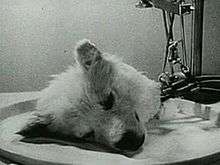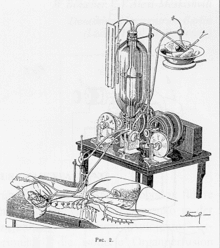Experiments in the Revival of Organisms
Experiments in the Revival of Organisms (Russian: Эксперименты по оживлению организма) is a 1940 motion picture which documents Soviet research into the resuscitation of clinically dead organisms.[1] It is available from the Prelinger Archives, and it is in the public domain. The operations are credited to Doctor Sergei Brukhonenko and Boris Levinskovsky, who were demonstrating a special heart-lung apparatus called the autojektor (or autojector), also referred to as the heart-lung machine, to the Second Congress of Russian Pathologists in Moscow.[2] It was filmed at the Institute of Experimental Physiology and Therapy, which is also in Moscow.[3] The heart-lung machine was designed and constructed by Brukhonenko, whose work in the film is said to have led to the first operations on heart valves.[4] The autojektor device demonstrated in the film is similar to modern ECMO machines, as well as the systems commonly used for renal dialysis in modern nephrology.
| Experiments in the Revival of Organisms | |
|---|---|
 Screenshot from the film showing the dog's head attached to Brukhonenko's autojektor | |
Release date | 1940 |
Running time | 19:31 |
| Country | Soviet Union |
| Language |
|
| Budget | £20,000 |
Synopsis
The film depicts and discusses a series of medical experiments. It begins with British scientist J. B. S. Haldane appearing and discussing how he has personally seen the procedures carried out in the film and have saved lives during the war. The experiments start with a heart of a canine, which is shown being isolated from a body; four tubes are then connected to the organ. Using an apparatus, the heart beats in the same manner as if it were in a living organism. The film then shows a lung in a tray, which is operated by bellows that oxygenate the blood.
Following the lung scene, the audience is then shown a heart-lung machine, composed of a pair of diaphragm linear pumps, venous and arterial, exchanging oxygen with a water reservoir. It is then seen supplying a canine head with oxygenated blood. The head is presented with external stimuli, which it responds to. Finally, a dog is brought to clinical death (depicted mostly via a graphical plot of lung and heart activity) by draining all blood from it. It is then left for ten minutes and connected to the heart-lung machine, which gradually returns the blood into the animal's circulation. After several minutes, the heart fibrillates, then restarts a normal rhythm. Respiration likewise resumes and the machine is removed. Over the ensuing ten days, the dog recovers from the procedure and continues living a healthy life. According to the film, several dogs were brought back to life using this method, including one which is an offspring of parents who were both also resuscitated.[5]
Reaction

Brukhonenko's decapitation experiment was remarked upon by George Bernard Shaw, who stated, "I am even tempted to have my own head cut off so that I can continue to dictate plays and books without being bothered by illness, without having to dress and undress, without having to eat, without having anything else to do other than to produce masterpieces of dramatic art and literature."[6]
Brukhonenko developed a new version of the autojektor (for use on humans) in the same year; it can be seen today on display at the Museum of Cardiovascular Surgery at the Bakulev Scientific Center of Cardiovascular Surgery in Russia.[7] Brukhonenko was posthumously awarded the prestigious Lenin Prize.[8]
Some commentators have questioned the film's authenticity, given that none of the more dubious experiments are shown in any full-frame shots. According to some scientists who claim to have seen the experiments in the film, the severed dog head only survived for a few minutes when attached to the artificial heart, as opposed to the hours claimed in the film.[9]
In popular culture
- In 2004 MF Doom released his song Fall Back / Titty Fat (through his album Venomous Villain) which begins and ends with excerpts from the experiment. The music video for this song largely consists of segments from the 1940 motion picture.
- In 2009, the band The Paper Chase used portions of the film in their video "What Should We Do with Your Body? (The Lightning)".[10]
- A portion of the plot of James Rollins' novel Bloodline is based on this experiment.
- The 1945 novel That Hideous Strength by C. S. Lewis makes reference to the experiments.
- Polish poet Wisława Szymborska references the experiment in her poem "The Experiment" circa 1967.[11]
- Metallica's video for their song "All Nightmare Long" is partially based on the film, and shows Soviet scientists reanimating a dead cat.
- In the video game Team Fortress 2, a cosmetic set for the Medic is called Canis Ex Machina in reference to the Soviet experiments in 1940.
- In Roald Dahl's 1960 short story William and Mary, a doctor says: "I saw a short medical film that had been brought over from Russia. It was a rather gruesome thing, but interesting. It showed a dog's head completely severed from the body, but with the normal blood supply being maintained through the arteries and veins by means of an artificial heart."
See also
References
- "Experiments in the Revival of Organisms". Prelinger Archives. Techfilm Studios, Moscow. Retrieved 28 April 2017.
- Krementsov, Nikolai (June 2009). "Off with your heads: isolated organs in early Soviet science and fiction". Studies in History and Philosophy of Science Part C: Studies in History and Philosophy of Biological and Biomedical Sciences. 40 (2): 87–100. doi:10.1016/j.shpsc.2009.03.001. PMC 2743238. PMID 19442924.
- Swain, Frank (2013-06-11). How to Make a Zombie: The Real Life (and Death) Science of Reanimation and Mind Control. Oneworld Publications. p. 39. ISBN 9781851689446.
- Konstantinov, Igor; Alexi-Meskishvili, Vladimir (2000). "Sergei S. Brukhonenko: The Development of the First Heart-Lung Machine for Total Body Perfusion". The Annals of Thoracic Surgery. 69 (3): 962–966. doi:10.1016/s0003-4975(00)01091-2. PMID 10750806. Retrieved 28 April 2017.
- "Experiments in the Revival of Organisms". Prelinger Archives. Techfilm Studios, Moscow. Retrieved 28 April 2017.
- "Sergej Sergejewitsch Brychonenko". Archived from the original on 2007-01-21. Retrieved 2010-12-14.
- "Museum of Cardiovascular Surgery". Archived from the original on 2006-02-08. Retrieved 2006-03-06.
- "ЛАБОРАТОРИЯ ЭКСПЕРИМЕНТАЛЬНОЙ ПАТОЛОГИИ". Archived from the original on January 29, 2007. Retrieved 2008-10-26.. sklifos.ru (in Russian)
- Bellows, Alan (2009). Alien Hand Syndrome: And Other Too-Weird-Not-to-Be-True Stories. Workman Publishing. pp. 32–3. ISBN 9780761152255.
- ""What Should We Do With Your Body? (The Lightning)" video". YouTube. Retrieved 2017-01-19.
- ""Wisława Szymborska III (The Experiment)" Poem".
External links
- Hill JD (1982). "John H. Gibbon, Jr. Part I. The development of the first successful heart-lung machine". The Annals of Thoracic Surgery. 34 (3): 337–341. doi:10.1016/S0003-4975(10)62507-6. PMID 7052001.
- Fou Adora Ann (1997). "John H. Gibbon. The first 20 years of the heart-lung machine". Texas Heart Institute Journal. 24 (1): 1–8. PMC 325389. PMID 9068131.
- Krementsov Nikolai (2009). "Off with your heads: isolated organs in early Soviet science and fiction". Studies in History and Philosophy of Science Part C: Studies in History and Philosophy of Biological and Biomedical Sciences. 40 (2): 87–100. doi:10.1016/j.shpsc.2009.03.001. PMC 2743238. PMID 19442924.
- Passaroni Andréia, Silva Marcos, Yoshida Winston (2014). "Cardiopulmonary bypass: development of John Gibbon's heart-lung machine". Revista Brasileira de Cirurgia Cardiovascular. 30 (2): 235–245. doi:10.5935/1678-9741.20150021. PMC 4462970. PMID 26107456.CS1 maint: multiple names: authors list (link)
- Blair-St Giles; et al. (1983). "Dying and death, with special reference to brain death. A bibliography". Resuscitation. 10 (4): 235–251. doi:10.1016/0300-9572(83)90026-6.
- Time Magazine reports on the film's premiere
- The Autojektor on display at the Scientific Center of Cardiovascular Surgery (in Russian) (via Wayback Machine)
- A medical paper on Brukhonenko's work (in Russian, requires PubMed access)
- Brukhonenko excerpt from "The Golden Book of Russia. The Year 2000"